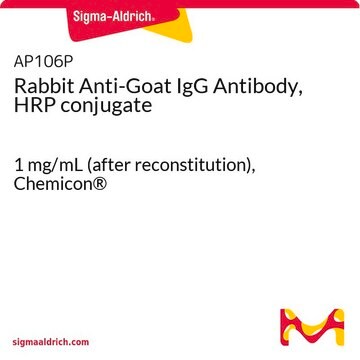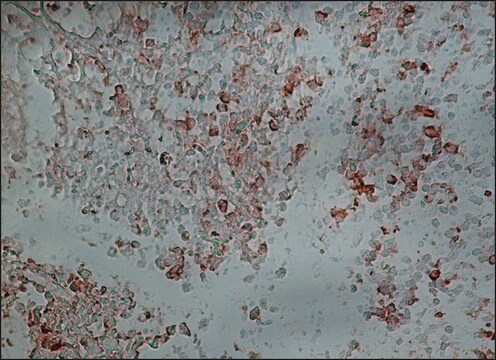AP180P
Donkey Anti-Goat IgG Antibody, HRP conjugate, Species Adsorbed
Chemicon®, from donkey
Synonym(s):
Anti-Rabbit IgG HRP, HRP Donkey Anti-Rabbit IgG
About This Item
Recommended Products
biological source
donkey
Quality Level
conjugate
peroxidase conjugate
antibody form
purified immunoglobulin
antibody product type
secondary antibodies
clone
polyclonal
species reactivity
goat
manufacturer/tradename
Chemicon®
technique(s)
ELISA: suitable
immunohistochemistry: suitable
western blot: suitable
isotype
IgG
shipped in
wet ice
target post-translational modification
unmodified
General description
Application
1:500-1:5,000 dilution can be used.
Optimal working dilutions must be determined by end user.
Quality
ELISA and Western Blots:
1:5,000-1:100,000 dilution can be used.
Physical form
Reconstitution:
Reconstitute with 500 μL of sterile distilled water.
Storage and Stability
After reconstitution the product is stable for several weeks at 2-8°C as an undiluted liquid. For extended storage after reconstitution, add an equal volume of glycerol to make a final concentration of 50% glycerol followed by storage at -20°C in undiluted aliquots for up to 12 months. Please note the concentration of protein (and buffer salts) will decrease to one-half of the original after the addition of glycerol. Avoid repeated freeze/thaw cycles.
WARNING: Use of sodium azide as a preservative will substantially inhibit the enzyme activity of HRP.
Legal Information
Not finding the right product?
Try our Product Selector Tool.
Storage Class Code
11 - Combustible Solids
WGK
WGK 3
Certificates of Analysis (COA)
Search for Certificates of Analysis (COA) by entering the products Lot/Batch Number. Lot and Batch Numbers can be found on a product’s label following the words ‘Lot’ or ‘Batch’.
Already Own This Product?
Find documentation for the products that you have recently purchased in the Document Library.
Our team of scientists has experience in all areas of research including Life Science, Material Science, Chemical Synthesis, Chromatography, Analytical and many others.
Contact Technical Service






